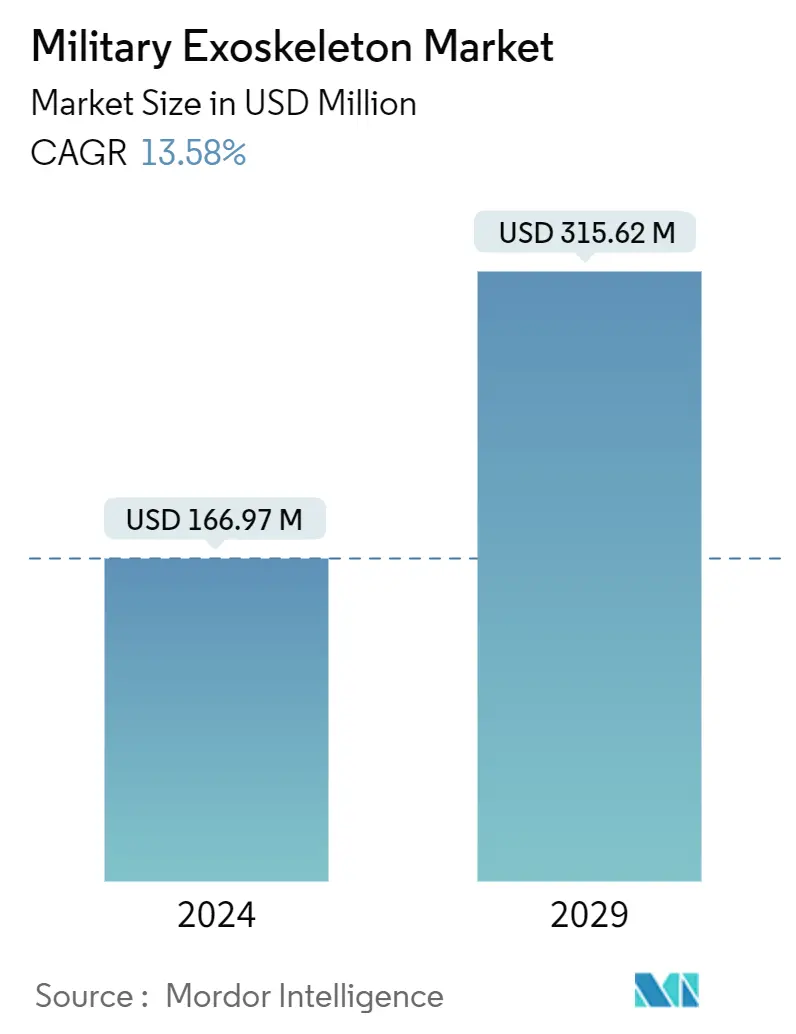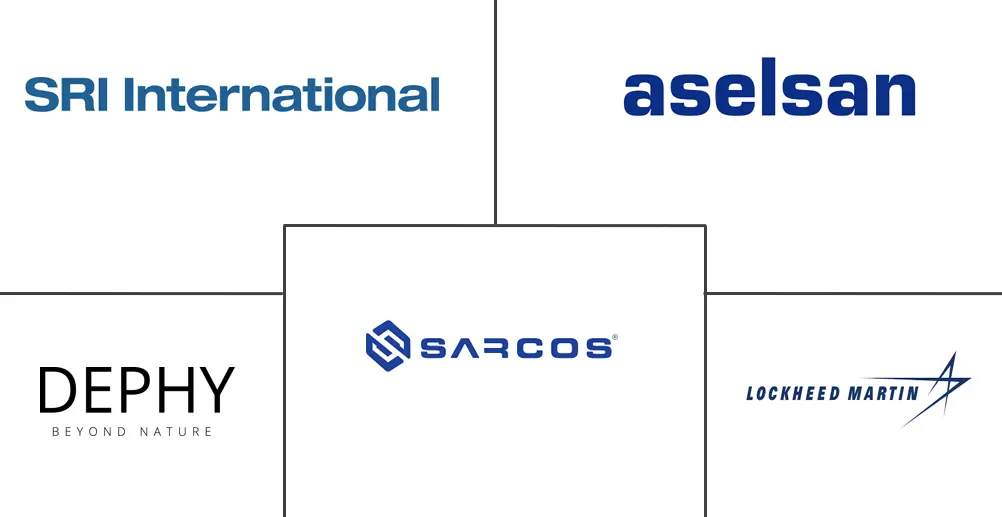Market Size of Military Exoskeleton Industry

| Study Period | 2019 - 2029 |
| Market Size (2024) | USD 166.97 Million |
| Market Size (2029) | USD 315.62 Million |
| CAGR (2024 - 2029) | 13.58 % |
| Fastest Growing Market | North America |
| Largest Market | Europe |
Major Players
*Disclaimer: Major Players sorted in no particular order |
Military Exoskeleton Market Analysis
The Military Exoskeleton Market size is estimated at USD 166.97 million in 2024, and is expected to reach USD 315.62 million by 2029, growing at a CAGR of 13.58% during the forecast period (2024-2029).
- Despite the impact of the COVID-19 pandemic on global economies, the market for military exoskeletons was negligibly impacted as the investments in emerging technologies remained unaffected.
- Technological advancements in modern warfare are the major driving factors for the military exoskeleton market. Efforts are being made to further increase the efficiency of military exoskeletons through the incorporation of new technologies, which are expected to further propel the growth of the market in the years to come.
- The focus on increasing the safety and efficiency of dismounted soldiers has led to the military investing in these technologies, as exoskeletons reduce the fatigue of soldiers while also giving them an extra layer of protection from the outside.
- Despite all the advantages that exoskeletons offer, the main hindrance to their adoption is the high purchase costs involved. Efforts are now being made to further reduce the manufacturing costs of these exoskeletons.
Military Exoskeleton Industry Segmentation
An exoskeleton is an external frame worn to support the body, either to help a person overcome an injury or to enhance their biological capacities. It is powered by a system of electric motors, and the frame gives limbs extra movement, strength, and endurance. Exoskeletons are used in the military sector in various combat and non-combat roles.
The military exoskeleton market is segmented into type, power, and geography. By type, the market is segmented into full-body exoskeleton and partial-body exoskeleton. By power, the market is segmented based on active exoskeleton and passive exoskeleton. Active exoskeletons are electrically powered and are used as an integrated power supply. They are used to enhance the activities of the personnel who wear them, while passive exoskeletons are simpler in structure and are mostly used to support the load on joints and bones. The report covers the market sizes and forecasts for the military exoskeleton market in major countries across different regions. For each segment, the market sizing and forecast have been represented by value (USD).
| Type | |
| Full-body Exoskeleton | |
| Partial-body Exoskeleton |
| Power | |
| Active Exoskeleton | |
| Passive Exoskeleton |
| Geography | |||||||
| |||||||
| |||||||
| |||||||
| Rest of the World |
Military Exoskeleton Market Size Summary
The military exoskeleton market is poised for significant growth, driven by advancements in modern warfare technologies and the increasing focus on enhancing the safety and efficiency of dismounted soldiers. Despite the challenges posed by high purchase costs, the market has shown resilience, with investments in emerging technologies remaining robust even during the COVID-19 pandemic. The integration of new technologies into military exoskeletons is expected to further accelerate market expansion. Active exoskeletons, which are electromechanical devices designed to improve strength and endurance, are anticipated to experience remarkable growth. However, challenges such as power supply inefficiencies and high design costs continue to pose obstacles, necessitating ongoing innovation in lightweight and flexible actuator designs.
North America is expected to lead the market growth, largely due to the substantial investments by the United States in research and development of exoskeleton technologies. The presence of numerous manufacturers and the high purchasing capacity in the region contribute to this trend. Notable developments include the testing of powered exoskeletons like the Dephy ExoBoot and Lockheed Martin's ONYX, which aim to enhance soldier mobility and reduce fatigue. Similarly, Canada is investing in soldier modernization programs, further driving market growth. The market is characterized by fragmentation, with global and regional players such as Lockheed Martin, SRI International, and Sarcos Technology actively expanding their presence through partnerships and investments in advanced exoskeleton technologies.
Military Exoskeleton Market Size - Table of Contents
-
1. MARKET DYNAMICS
-
1.1 Market Overview
-
1.2 Market Drivers
-
1.3 Market Restraints
-
1.4 Porter's Five Forces Analysis
-
1.4.1 Bargaining Power of Buyers/Consumers
-
1.4.2 Bargaining Power of Suppliers
-
1.4.3 Threat of New Entrants
-
1.4.4 Threat of Substitute Products
-
1.4.5 Intensity of Competitive Rivalry
-
-
-
2. MARKET SEGMENTATION
-
2.1 Type
-
2.1.1 Full-body Exoskeleton
-
2.1.2 Partial-body Exoskeleton
-
-
2.2 Power
-
2.2.1 Active Exoskeleton
-
2.2.2 Passive Exoskeleton
-
-
2.3 Geography
-
2.3.1 North America
-
2.3.1.1 United States
-
2.3.1.2 Canada
-
-
2.3.2 Europe
-
2.3.2.1 United Kingdom
-
2.3.2.2 France
-
2.3.2.3 Germany
-
2.3.2.4 Russia
-
2.3.2.5 Rest of Europe
-
-
2.3.3 Asia-Pacific
-
2.3.3.1 China
-
2.3.3.2 India
-
2.3.3.3 Japan
-
2.3.3.4 South Korea
-
2.3.3.5 Rest of Asia-Pacific
-
-
2.3.4 Rest of the World
-
-
Military Exoskeleton Market Size FAQs
How big is the Military Exoskeleton Market?
The Military Exoskeleton Market size is expected to reach USD 166.97 million in 2024 and grow at a CAGR of 13.58% to reach USD 315.62 million by 2029.
What is the current Military Exoskeleton Market size?
In 2024, the Military Exoskeleton Market size is expected to reach USD 166.97 million.

